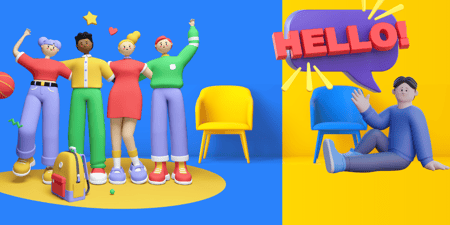What is SaaS Sprawl (and How Can You Fix It?)
 SaaS (Software as a Service) first appeared on the scene in the early 2000s. It was a shiny, new concept that promised to redefine the way companies got work done. Basically, it’s the now-common practice of licensing software over the internet and is usually tied to a subscription. SaaS gives access to tools and services that used to require in-office servers and custom-built software, which was expensive and often impractical for a lot of companies.
SaaS (Software as a Service) first appeared on the scene in the early 2000s. It was a shiny, new concept that promised to redefine the way companies got work done. Basically, it’s the now-common practice of licensing software over the internet and is usually tied to a subscription. SaaS gives access to tools and services that used to require in-office servers and custom-built software, which was expensive and often impractical for a lot of companies.
Fast forward to today, and it has evolved into an integral part of our business lives. SaaS applications like Google Workspace, Salesforce, and Dropbox have become as common as morning coffee.
However, just as too much coffee can make us jittery, an overload of SaaS solutions has given birth to a beast known as "SaaS Sprawl" (don't worry, it's not as scary as it sounds). In this article, we'll discuss SaaS Sprawl, its implications, and how to keep it under control.
Jump to...
- what is saas sprawl?
- the ‘appy’ complications of saas sprawl
- shadow it: what it is and why it matters
- how to fix saas sprawl
- wrap-up
what is SaaS Sprawl?
 "SaaS Sprawl" might sound like a new yoga pose, but trust us, it's not that relaxing. The term Saas Sprawl describes the situation when a company has a large number of SaaS applications but with no standards for app categories, procurement, monitoring, or employee training.
"SaaS Sprawl" might sound like a new yoga pose, but trust us, it's not that relaxing. The term Saas Sprawl describes the situation when a company has a large number of SaaS applications but with no standards for app categories, procurement, monitoring, or employee training.
SaaS companies that are now household names started exploding in the late 2000s and early 2010s. Software like Dropbox, Slack, Zoom, and Trello showed just how successful point solution companies could be. The simplicity and quick implementation of these applications has had some amazing impacts on today’s companies. For example:
- As of 2022, the SaaS industry had a global market size of nearly $200 billion (Zippia)
- At its current growth rate, the industry will grow to $1 trillion over the next 10 years.
- Companies with more than 1,000 employees average over 250 SaaS applications (TechCrunch).
- The average corporation’s SaaS spend exceeds $4 million annually (Pendo).
This is great news for people launching new software applications, but if you work in an office you’ve probably experienced more frustration than excitement. For people working at larger companies, having 10 or more work-related apps on your phone is increasingly common. As Nadir Ali of Inpixon pointed out in a 2021 SHRM article, “Simply finding the desired app can be a chore, and switching apps can interrupt the user's workflow.”
Another side-effect of the SaaS growth is increasingly-common “SaaS Vendor Management software”, meant to help with managing SaaS Sprawl. Our research shows that “SaaS Management Platform” started consistently appearing in online searches midway through 2017. This was just a few months after Beamy - one of the first companies to enter this category - was founded. Since then, companies like Productiv and Vendr (both founded in 2018) have joined the growing number of SaaS Vendor Management and SaaS Contract Management companies.
the ‘appy’ complications of SaaS Sprawl
With SaaS sprawl, companies often find themselves in a peculiar situation where many of their apps are either underused or duplicated. It’s a bit like buying a new shirt every week even though you keep wearing the one that’s 5 years old (also known as the “Steve Jobs” look). In both cases, whoever’s paying has the best intentions at the time. However, it’s also clear the person paying isn’t thinking too much about what they have vs. what they need before opening their wallet.
![]() Then, there’s the problem of different departments using different SaaS apps for the same thing (and the problem usually gets worse as a company grows). Eventually, you’re in a situation where you have to communicate with someone who speaks a different language but you don’t have a translator. The resulting breakdown in communication and increase in support tickets rivals that hyperactive group chat you had to mute.
Then, there’s the problem of different departments using different SaaS apps for the same thing (and the problem usually gets worse as a company grows). Eventually, you’re in a situation where you have to communicate with someone who speaks a different language but you don’t have a translator. The resulting breakdown in communication and increase in support tickets rivals that hyperactive group chat you had to mute.
Adding to this, research by Productiv found that companies are using 254 apps and tools on average, indicating the extent of SaaS sprawl. As we mentioned earlier, this can be a huge time-waster for existing employees and an even bigger one for new employees during onboarding.
It’s easy to underestimate how much time is wasted every day just switching between different tools and sorting through notifications, and that doesn’t even include the time it takes to learn how to use everything. Moreover, only 45% of registered accounts actively use the SaaS tools their company provides, but most leaders aren’t able to see and identify this problem.
Furthermore, SaaS sprawl is not only harming productivity on an individual level, but it can create deeper silos between departments. According to Qatalog, nearly 60% of SaaS users aren’t sure if all of their company departments use the same apps. This becomes especially problematic when teams need to share data and communicate between departments.
And then, there’s the issue of the SaaS contracts themselves. As Vendr points out, most companies sign up and never revisit their agreements, which can have three major impacts:
- The buyer may not get a fair price,
- The price increases over time, and
- The risk of paying to maintain “shelfware”.
As businesses change and grow, most continue to add new licenses to their existing applications, but few have a process in place to evaluate what’s already in use and remove what isn’t needed. This means that - on top of everything else - companies find themselves wasting money thanks to a license surplus.
Shadow IT: what it is and why it matters
 To paraphrase IBM, Shadow IT is any software, hardware, or system that’s used at a company for work purposes without the knowledge or oversight of someone in IT. We’re focusing on the “software” part of that trio today, but it’s worth keeping in mind that “hardware” includes common examples like personal laptops used for work purposes.
To paraphrase IBM, Shadow IT is any software, hardware, or system that’s used at a company for work purposes without the knowledge or oversight of someone in IT. We’re focusing on the “software” part of that trio today, but it’s worth keeping in mind that “hardware” includes common examples like personal laptops used for work purposes.
Shadow IT is increasingly in the spotlight because of how easy it is for individuals to install and use software at work without involving IT. An easy example is when a group of employees start using a popular new messaging app because it has some “cool new features” that the work-approved messaging platform doesn’t have. Examples like this are often done with the best intentions, but they can have major consequences.
Consider another example of an employee using their personal Dropbox account to create and share sensitive information, even though their company uses Office 365. By using a personal account, the employee has unintentionally created a huge gap in the company’s security.
Even though the IT department may have set up all kinds of security measures with Office 365, that security doesn’t cover the personal account at all. This example, in particular, is a great example of how important managing Shadow IT is (and how difficult it can be). Not everyone knows what it takes to properly secure the applications their company uses, and that task only gets harder when the total number of apps is growing by the day.
how to fix SaaS Sprawl
 Step 1: Audit
Step 1: Audit
The most important step is often the most boring; you need a comprehensive audit of all the SaaS applications in your organization. At the very least, you need to have a thorough understanding of subscription costs, how much the apps are used, and what plans there are for renewing (if any).
This audit also needs to include talking with employees directly. While reviewing subscription information and usage data helps you understand how the apps you know about are being used, it doesn’t give you any info about potential Shadow IT. Talking with employees will help reveal software and apps that are being used for work purposes without IT’s knowledge.
Step 2: Engage
.png?width=400&height=218&name=engage%20(1).png) Picking up from the conversations with employees about what apps they’re using, this step is about uncovering preferences and pain points across departments. Assuming you found features that appear to overlap during your audit, this next step is where you find out why different teams are using different apps for the same thing.
Picking up from the conversations with employees about what apps they’re using, this step is about uncovering preferences and pain points across departments. Assuming you found features that appear to overlap during your audit, this next step is where you find out why different teams are using different apps for the same thing.
Sometimes you’ll find two managers who have “always done it this way” or teams that didn’t check to see what services the company already subscribed to before signing up for something new. In other cases, you might find out that there are specific features one of the apps has that the other doesn’t, and those features actually make the additional subscription useful.
No matter what you find, this part of the process is critical; without knowing who needs what services and why, you risk removing critical features that people count on for getting their work done efficiently.
Step 3: Restructure
 Now it’s time to start putting software on the “chopping block”. Discuss what you’ve found with whoever will be impacted by a potential change, and work on getting buy-in from everyone (or at least a majority of the affected people).
Now it’s time to start putting software on the “chopping block”. Discuss what you’ve found with whoever will be impacted by a potential change, and work on getting buy-in from everyone (or at least a majority of the affected people).
Keep in mind that during this process, the actual users of the software might disagree with your recommendations - and that’s perfectly OK. Sometimes you’ll recommend shifting to an application that, from your perspective, is objectively better than what’s being used, only to get significant push-back. In the end, the choice should be up to whoever will be using the solution (as long as that choice doesn’t mean spending a bunch of company money unnecessarily).
Step 4: Optimize
Speaking of unnecessary spending, now we need to look at the services we’re moving forward with and figure out how to get the best deal on them. For most companies, this can be done by either signing up for a SaaS vendor management system (which costs more money), or by setting up an internal management tool. The second option will save money (perhaps quite a lot of money), but it takes much more time to set up and maintain.
As far as the vendor management systems are concerned, we mentioned some of the most popular options earlier: Vendr, Productiv, and Beamy. With these options, just be prepared: they aren’t targeted at small businesses. On Vendr’s price page, they’re transparent in showing that their “Starter” plan is intended for “companies with $400K-$1M annual SaaS spend”.
 Step 5: Maintain
Step 5: Maintain
Fixing SaaS Sprawl is not a “set and forget” kind of thing. Getting through the first 4 steps puts your company in a great place moving forward, but hopefully, at this point, you’ve seen how easy it is to slide right back into chaos. To make sure your hard work doesn’t go to waste, company-wide standards have to be put in place, and ongoing training will be necessary.
For example, if you decided to drop one of the two project management apps that were being used at your company, you can’t just tell the people to install the new app and assume everything will be fine. Current employees should receive hands-on training to speed up their adoption of the app. Failing to onboard employees to new apps quickly will just cause more Shadow IT to pop up more quickly.
Conclusion
SaaS Sprawl is undeniably a modern-day challenge for organizations, disrupting productivity, wasting resources, and creating unnecessary confusion.
Through careful auditing, engagement, restructuring, optimizing, and maintenance, businesses can not only combat SaaS Sprawl but also drive better synergy across their departments, heighten productivity, and ultimately create better work environments.
If you found this article interesting or helpful, please support us by subscribing to this blog below and sharing the article on your social media platforms!
.png?width=200&height=80&name=lexcan%20simplify%20work%20banner%20v4%20(200x100).png)






